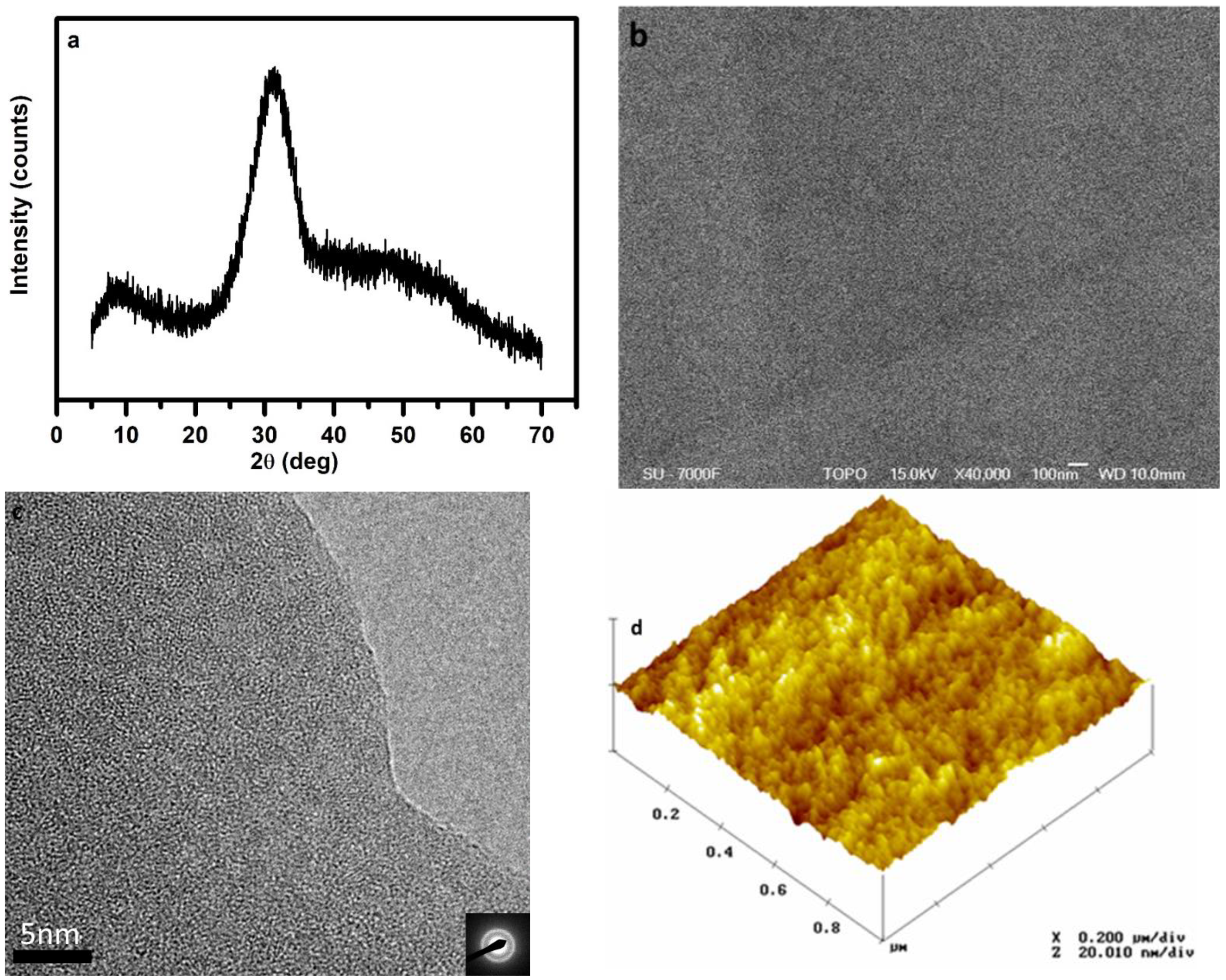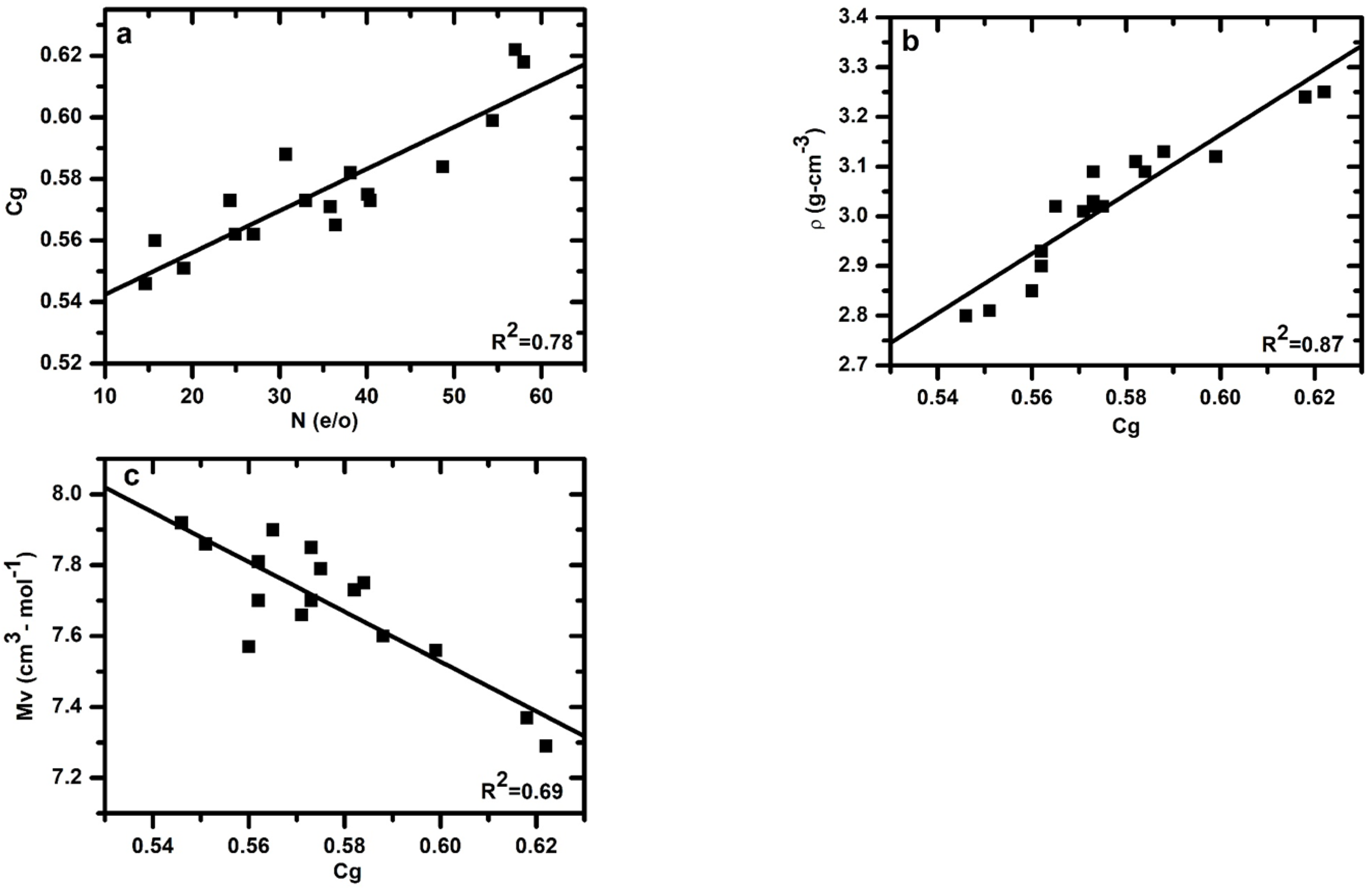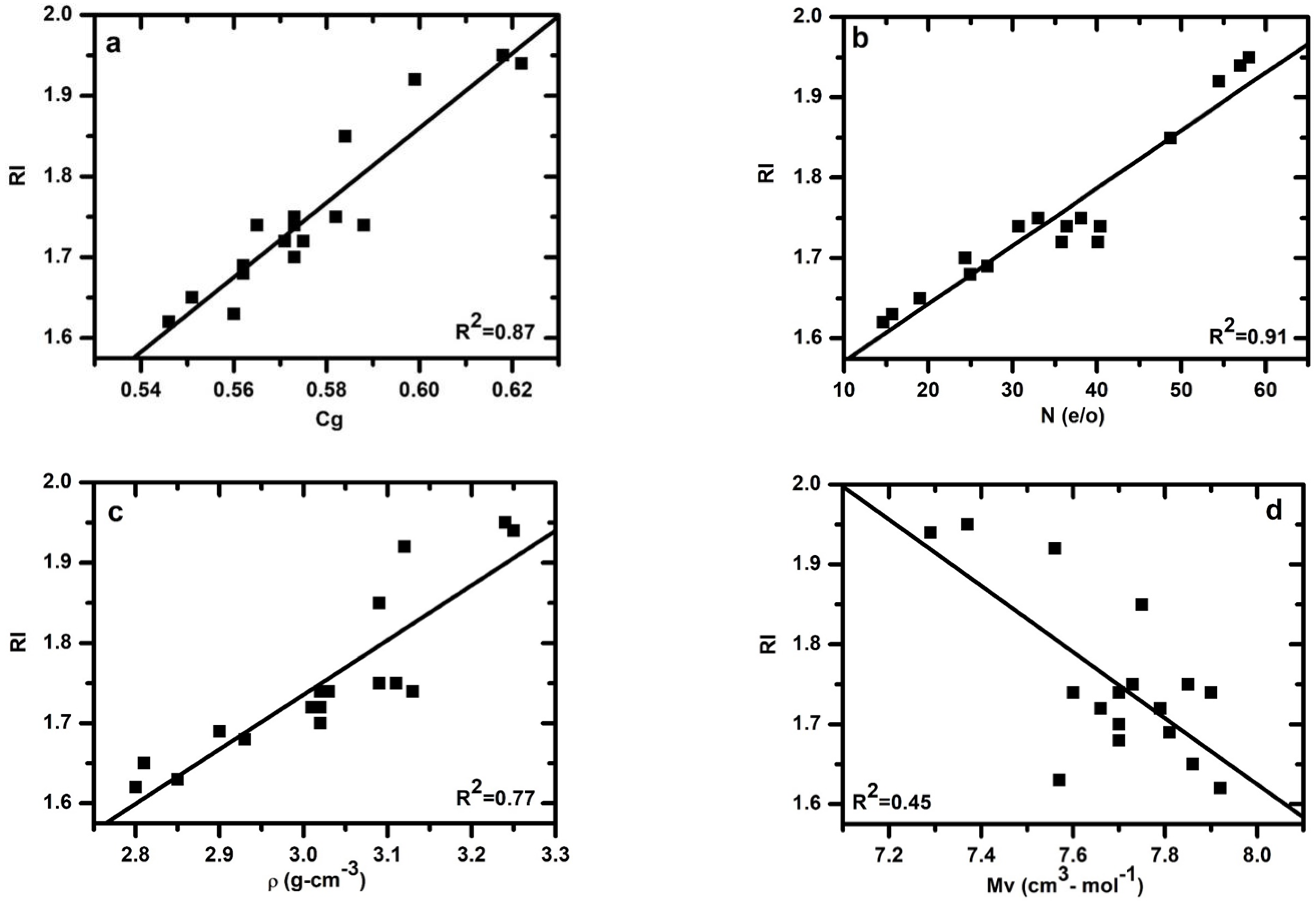Impact of the Atomic Packing Density on the Properties of Nitrogen-Rich Calcium Silicate Oxynitride Glasses
Abstract
:1. Introduction
2. Experimental
3. Results
3.1. Glass Stoichiometry and Morphology
3.2. Effect of Atomic Packing Density on Bridging Oxygen and Average Coordination Number
3.3. Effect of Atomic Packing Density on Measured Glass Density and Calculated Molar Volume
3.4. Effect of Atomic Packing Density on Glass Transition and Crystallization Temperatures
3.5. Effect of Atomic Packing Density on Hardness
3.6. Effect of Atomic Packing Density on Refractive Index
4. Discussion
5. Conclusions
Funding
Institutional Review Board Statement
Informed Consent Statement
Data Availability Statement
Acknowledgments
Conflicts of Interest
References
- Aujla, R.S.; Lengward, G.; Lewis, M.H.; Seymour, E.F.W.; Styles, G.A.; West, G.W. An NMR-Study of Silicon Coordination in Y-Si-Al-O-N Glasses. Philos. Mag. B 1986, 54, L51–L56. [Google Scholar] [CrossRef]
- Brow, R.; Pantano, C.; Boyd, D.C. Nitrogen Coordination in Oxynitride Glasses. J. Am. Ceram. Soc. 1984, 67, c72–c74. [Google Scholar] [CrossRef]
- Loehman, R.E. Preparation and Properties of Oxynitride Glasses. J. Non-Cryst. Solids. 1983, 56, 123–134. [Google Scholar] [CrossRef]
- Sakka, S.; Kamiya, K.; Yoko, T. Preparation and Properties of Ca-Al-Si-O-N Oxynitride Glasses. J. Non-Cryst. Solids. 1983, 56, 147–152. [Google Scholar] [CrossRef]
- Sakka, S. Structure, Properties and Application of Oxynitride Glasses. J. Non-Cryst. Solids. 1995, 181, 215–224. [Google Scholar] [CrossRef]
- Hampshire, S. Oxynitride glasses, their properties and crystallisation—A review. J. Non-Cryst. Solids. 2003, 316, 64–73. [Google Scholar] [CrossRef]
- Becher, P.F.; Hampshire, S.; Pomeroy, M.J.; Hoffmann, M.J.; Lance, M.J.; Satet, R.L. An Overview of the Structure and Properties of Silicon-Based Oxynitride Glasses. Int. J. Appl. Glass Sci. 2011, 2, 63–83. [Google Scholar] [CrossRef]
- Ali, S.; Jonson, B.; Pomeroy, M.J.; Hampshire, S. Issues associated with the development of transparent oxynitride glasses. Ceram. Int. 2015, 41, 3345–3354. [Google Scholar] [CrossRef]
- Hakeem, A.S.; Grins, J.; Esmaeilzadeh, S. La-Si-O-N glasses—Part I. Extension of the glass forming region. J. Eur. Ceram. Soc. 2007, 27, 4773–4781. [Google Scholar] [CrossRef]
- Hakeem, A.S.; Grins, J.; Esmaeilzadeh, S. La-Si-O-N glasses—Part II: Vickers hardness and refractive index. J. Eur. Ceram. Soc. 2007, 27, 4783–4787. [Google Scholar] [CrossRef]
- Leonova, E.; Hakeem, A.S.; Jansson, K.; Stevensson, B.; Shen, Z.; Grins, J.; Esmaeilzadeh, S.; Edén, M. Nitrogen-rich La-Si-Al-O-N oxynitride glass structures probed by solid state NMR. J. Non-Cryst. Solids. 2008, 354, 49–60. [Google Scholar] [CrossRef]
- Sharafat, A.; Grins, J.; Esmaeilzadeh, S. Glass-forming region in the Ca–Si–O–N system using CaH2 as Ca source. J. Eur. Ceram. Soc. 2008, 28, 2659–2664. [Google Scholar] [CrossRef]
- Sharafat, A. Preparation, Characterization and Properties of Nitrogen Rich Glasses in Alkaline Earth-Si-O-N Systems; Institutionen för Fysikalisk Kemi, Oorganisk Kemi och Strukturkemi: Stockholm, Sweden, 2009; p. 116. [Google Scholar]
- Sharafat, A.; Forslund, B.; Grins, J.; Esmaeilzadeh, S. Formation and properties of nitrogen-rich strontium silicon oxynitride glasses. J. Mater. Sci. 2009, 44, 664–670. [Google Scholar] [CrossRef]
- Ali, S.; Jonson, B. Glasses in the Ba-Si-O-N System. J. Am. Ceram. Soc. 2011, 94, 2912–2917. [Google Scholar] [CrossRef]
- Ali, S. Elastic Properties and Hardness of Mixed Alkaline Earth Silicate Oxynitride Glasses. Materials 2022, 15, 5022. [Google Scholar] [CrossRef]
- Acikgoz, A.; Demircan, G.; Yılmaz, D.; Aktas, B.; Yalcin, S.; Yorulmaz, N. Structural, mechanical, radiation shielding properties and albedo parameters of alumina borate glasses: Role of CeO2 and Er2O3. Mater. Sci. Eng. B 2022, 276, 115519. [Google Scholar] [CrossRef]
- Aktas, B.; Acikgoz, A.; Yilmaz, D.; Yalcin, S.; Dogru, K.; Yorulmaz, N. The role of TeO2 insertion on the radiation shielding, structural and physical properties of borosilicate glasses. J. Nucl. Mater. 2022, 563, 153619. [Google Scholar] [CrossRef]
- Fidan, M.; Acikgoz, A.; Demircan, G.; Yilmaz, D.; Aktas, B. Optical, structural, physical, and nuclear shielding properties, and albedo parameters of TeO2–BaO–B2O3–PbO–V2O5 glasses. J. Phys. Chem. Solids 2022, 163, 110543. [Google Scholar] [CrossRef]
- Kohli, J.T.; Shelby, J.E. Formation and Properties of Rare-Earth Aluminosilicate Glasses. Phys. Chem. Glasses 1991, 32, 67–71. [Google Scholar]
- Tanabe, S.; Hirao, K.; Soga, N. Elastic Properties and Molar Volume of Rare-Earth Aluminosilicate Glasses. Am. Ceram. Soc. 1992, 75, 503–506. [Google Scholar] [CrossRef]
- Murakami, Y.; Yamamoto, H. Properties of Oxynitride Glasses in the Ln-Si-Al-O-N Systems (Ln = Rare-Earth). Nippon. Seramikkusu Kyokai Gakujutsu Ronbunshi-J. Ceram. Soc. Jpn. 1994, 102, 231–236. [Google Scholar] [CrossRef] [Green Version]
- Ohashi, M.; Nakamura, K.; Hirao, K.; Kanzaki, S. Formation and Properties of Ln-Si-O-N Glasses (Ln = Lanthanides or Y). J. Am. Ceram. Soc. 1995, 78, 71–76. [Google Scholar] [CrossRef]
- Ramesh, R.; Nestor, E.; Pomeroy, M.J.; Hampshire, S. Formation of Ln-Si-Al-O-N glasses and their properties. J. Eur. Ceram. Soc. 1997, 17, 1933–1939. [Google Scholar] [CrossRef]
- Becher, P.F.; Waters, S.B.; Westmoreland, C.G.; Riester, L. Compositional effects on the properties of Si-Al-Re-based oxynitride glasses (RE = La, Nd, Gd, Y, or Lu). J. Am. Ceram. Soc. 2002, 85, 897–902. [Google Scholar] [CrossRef]
- Sharafat, A.; Bo, J. Compositional effects on the properties of high nitrogen content alkaline-earth silicon oxynitride glasses, AE = Mg, Ca, Sr, Ba. J. Eur. Ceram. Soc. 2011, 31, 611–618. [Google Scholar]
- Rouxel, T. Elastic properties and short-to medium-range order in glasses. J. Am. Ceram. Soc. 2007, 90, 3019–3039. [Google Scholar]
- Sharafat, A.; Grins, J.; Esmaeilzadeh, S. Hardness and refractive index of Ca-Si-O-N glasses. J. Non-Cryst. Solids 2009, 355, 301–304. [Google Scholar] [CrossRef]
- Shannon, R.D. Revised Effective Ionic-Radii and Systematic Studies of Interatomic Distances in Halides and Chalcogenides. Acta Cryst. A 1976, 32, 751–767. [Google Scholar] [CrossRef]
- Pastuszak, R.; Verdier, P. M-Si-Al-O-N Glasses (M = Mg, Ca, Ba, Mn, Nd), Existence Range and Comparative-Study of Some Properties. J. Non-Cryst. Solids 1983, 56, 141–146. [Google Scholar] [CrossRef]
- Desmaisonbrut, M.; Desmaison, J. The Reactivity in Oxygen of 2 Ca-Si-Al-O-N, Mn-Si-Al-O-N Oxynitride Glasses. Solid State Ion. 1988, 26, 153. [Google Scholar]
- Desmaisonbrut, M.; Desmaison, J.; Verdier, P. Oxidation Behavior of an Oxynitride Glass in the System Ca-Si-Al-O-N. J. Non-Cryst. Solids 1988, 105, 323–329. [Google Scholar] [CrossRef]
- Sharafat, A.; Berastegui, P.; Esmaeilzadeh, S.; Eriksson, L.; Grins, J. A cubic calcium oxynitrido-silicate, Ca2.89Si2N1.76O4.24. Acta Crystallogr. Sect. E Struct. Rep. Online 2011, 67, i66. [Google Scholar] [PubMed]
- Rouxel, T.; Dely, N.; Sangleboeuf, J.C.; Deriano, S.; LeFloch, M.; Beuneu, B.; Hampshire, S. Structure-property correlations in Y-Ca-Mg-sialon glasses: Physical and mechanical properties. J. Am. Ceram. Soc. 2005, 88, 889–896. [Google Scholar]
- Sellappan, P.; Sharafat, A.; Keryvin, V.; Houizot, P.; Rouxel, T.; Grins, J.; Esmaeilzadeh, S. Elastic properties and surface damage resistance of nitrogen-rich (Ca,Sr)-Si-O-N glasses. J. Non-Cryst. Solids 2010, 356, 2120–2126. [Google Scholar]
- Lv, P.; Wang, C.; Stevensson, B.; Yu, Y.; Wang, T.; Edén, M. Impact of the cation field strength on physical properties and structures of alkali and alkaline-earth borosilicate glasses. Ceram. Int. 2022, 48, 18094–18107. [Google Scholar]
- Pönitzsch, A.; Nofz, M.; Wondraczek, L.; Deubener, J. Bulk elastic properties, hardness and fatigue of calcium aluminosilicate glasses in the intermediate-silica range. J. Non-Cryst. Solids 2016, 434, 1–12. [Google Scholar]
- Rouxel, T. What we can learn from crystals about the mechanical properties of glass. J. Ceram. Soc. Jpn. 2022, 130, 519–530. [Google Scholar]
- Deriano, S.; Rouxel, T.; LeFloch, M.; Beuneu, B. Structure and mechanical properties of alkali-alkaline earth-silicate glasses. Phys. Chem. Glasses 2004, 45, 37–44. [Google Scholar]
- Homeny, J.; Mcgarry, D.L. Preparation and Mechanical-Properties of Mg-Al-Si-O-N Glasses. J. Am. Ceram. Soc. 1984, 67, C225–C227. [Google Scholar]
- Sharafat, A.; Grins, J.; Esmaeilzadeh, S. Properties of high nitrogen content mixed alkali earth oxynitride glasses (AE(x)Ca(1−x))(1.2(1))SiO1.9(1)N0.86(6), AE = Mg, Sr, Ba. J. Non-Cryst. Solids 2009, 355, 1259–1263. [Google Scholar]
- Gueguen, Y.; Sharafat, A.; Grins, J.; Rouxel, T. Viscosity of high-nitrogen content Ca-Si-O-N glasses. J. Am. Ceram. Soc. 2010, 30, 3455–3458. [Google Scholar]
- Denisse, C.M.M.; Troost, K.Z.; Elferink, J.B.O.; Habraken, F.H.P.M.; van der Weg, W.F.; Hendriks, M. Plasma-enhanced growth and composition of silicon oxynitride films. J. Appl. Phys. 1986, 60, 2536–2542. [Google Scholar]
- Hampshire, S.; Nestor, E.; Flynn, R.; Besson, J.L.; Rouxel, T.; Lemercier, H.; Goursat, P.; Sebai, M.; Thompson, D.P.; Liddell, K. Yttrium Oxynitride Glasses—Properties and Potential for Crystallization to Glass-Ceramics. J. Eur. Ceram. Soc. 1994, 14, 261–273. [Google Scholar]
- Menke, Y.; Peltier-Baron, V.; Hampshire, S. Effect of rare-earth cations on properties of sialon glasses. J. Non-Cryst. Solids 2000, 276, 145–150. [Google Scholar]
- Becher, P.F.; Ferber, M.K. Temperature-Dependent Viscosity of SiREAl-Based Glasses as a Function of N:O and RE:Al Ratios (RE = La, Gd, Y, and Lu). J. Am. Ceram. Soc. 2004, 87, 1274–1279. [Google Scholar]
- Hampshire, S.; Pomeroy, M.J. Effect of composition on viscosities of rare earth oxynitride glasses. J. Non-Cryst. Solids. 2004, 344, 1–7. [Google Scholar]
- Lofaj, F.; Deriano, S.; LeFloch, M.; Rouxel, T.; Hoffmann, M.J. Structure and rheological properties of the RE-Si-Mg-O-N (RE = Sc, Y, La, Nd, Sm, Gd, Yb and Lu) glasses. J. Non-Cryst. Solids 2004, 344, 8–16. [Google Scholar]
- Lofaj, F.; Satet, R.; Hoffmann, M.J.; de Lopez, A.R. Thermal expansion and glass transition temperature of the rare-earth doped oxynitride glasses. J. Eur. Ceram. Soc. 2004, 24, 3377–3385. [Google Scholar]
- Hampshire, S.; Hanifi, A.R.; Genson, A.; Pomeroy, M.J. Ca-Si-Al-O-N glasses: Effects of fluorine on glass formation and properties, Key. Eng. Mater. 2007, 352, 165–172. [Google Scholar]
- Iftekhar, S.; Pahari, B.; Okhotnikov, K.; Jaworski, A.; Stevensson, B.; Grins, J.; Edén, M. Properties and Structures of RE2O3–Al2O3–SiO2 (RE = Y, Lu) Glasses Probed by Molecular Dynamics Simulations and Solid-State NMR: The Roles of Aluminum and Rare-Earth Ions for Dictating the Microhardness. J. Phys. Chem. C 2012, 116, 18394–18406. [Google Scholar]
- Bäck, L.G.; Ali, S.; Karlsson, S.; Möncke, D.; Kamitsos, E.I.; Jonson, B. Mixed alkali/alkaline earth-silicate glasses: Physical properties and structure by vibrational spectroscopy. Int. J. Appl. Glass Sci. 2019, 10, 349–362. [Google Scholar] [CrossRef]
- Tredway, W.K.; Risbud, S.H. Melt Processing and Properties of Barium-Sialon Glasses. J. Am. Ceram. Soc. 1983, 66, 324–327. [Google Scholar] [CrossRef]
- Hanada, T.; Naotaka, U.; Naohire, S. Prepartion, properties and bond character of nitrogen in calcium silicon oxynitride glasses. J. Ceram. Soc. Jpn. 1988, 96, 281–289. [Google Scholar] [CrossRef]
- Hanifi, A.R.; Genson, A.; Pomeroy, M.J.; Hampshire, S. An introduction to the glass formation and properties of Ca-Si-Al-O-N-F glasses. Mater. Sci. Forum 2007, 554, 17–23. [Google Scholar] [CrossRef]
- Lemercier, H.; Rouxel, T.; Fargeot, D.; Besson, J.L.; Piriou, B. Yttrium SiAlON glasses: Structure and mechanical properties—Elasticity and viscosity. J. Non-Cryst. Solids 1996, 201, 128–145. [Google Scholar] [CrossRef]
- Zheng, Q.J.; Potuzak, M.; Mauro, J.C.; Smedskjaer, M.M.; Youngman, R.E.; Yue, Y.Z. Composition-structure-property relationships in boroaluminosilicate glasses. J. Non-Cryst. Solids 2012, 358, 993–1002. [Google Scholar] [CrossRef]
- García-Bellés, Á.R.; Monzó, M.; Barba, A.; Clausell, C.; Pomeroy, M.J.; Hanifi, A.R.; Hampshire, S. Factors Controlling Properties of Ca-Mg, Ca-Er, Ca-Nd, or Ca-Y-Modified Aluminosilicate Glasses Containing Nitrogen and Fluorine. J. Am. Ceram. Soc. 2013, 96, 2839–2845. [Google Scholar] [CrossRef]
- Hakeem, A.S.; Ali, S.; Jonson, B. Preparation and properties of mixed La–Pr silicate oxynitride glasses. J. Non-Cryst. Solids 2013, 368, 93–97. [Google Scholar] [CrossRef]
- Iftekhar, S.; Grins, J.; Edén, M. Composition–property relationships of the La2O3–Al2O3–SiO2 glass system. J. Non-Cryst. Solids 2010, 356, 1043–1048. [Google Scholar] [CrossRef]
- Coon, D.N.; Doyle, T.E.; Weidner, J.R. Refractive-Indexes of Glasses in the Y-Al-Si-O-N System. J. Non-Cryst. Solids 1989, 108, 180–186. [Google Scholar] [CrossRef]
- Dimitrov, V.; Komatsu, T. Electronic polarizability, optical basicity and non-linear optical properties of oxide glasses. J. Non-Cryst. Solids 1999, 249, 160–179. [Google Scholar] [CrossRef]





| Glass ID | Glass Composition | Ca/ e/o | Si/ e/o | O/ e/o | N/ e/o | X:Si | ||
|---|---|---|---|---|---|---|---|---|
| 1 | Ca3.41Si10O19.75N2.45 | 14.6 | 85.4 | 84.3 | 15.7 | 2.22 | 3.709 | 2.543 |
| 2 | Ca5.29Si10O21.61N2.46 | 20.9 | 79.1 | 85.4 | 14.6 | 2.41 | 2.582 | 2.413 |
| 3 | Ca4.90Si10O20.17N3.15 | 19.7 | 80.3 | 81.0 | 19.0 | 2.33 | 3.606 | 2.470 |
| 4 | Ca6.52Si10O20.02N4.43 | 24.6 | 75.4 | 75.1 | 24.9 | 2.45 | 3.511 | 2.408 |
| 5 | Ca9.3Si10O22.18N4.75 | 31.8 | 68.2 | 75.7 | 24.3 | 2.69 | 3.365 | 2.223 |
| 6 | Ca6.67Si10O19.47N4.8 | 25.0 | 75.0 | 73.0 | 27.0 | 2.43 | 3.500 | 2.415 |
| 7 | Ca11.81Si10O22.06N6.50 | 37.1 | 62.9 | 69.3 | 30.7 | 2.86 | 3.258 | 2.108 |
| 8 | Ca8.03Si10O17.92N6.65 | 28.7 | 71.3 | 64.2 | 35.8 | 2.46 | 3.424 | 2.399 |
| 10 | Ca14.65Si10O23.12N7.69 | 42.0 | 58.0 | 67.0 | 33.0 | 3.08 | 3.155 | 1.935 |
| 9 | Ca9.14Si10O17.37N7.84 | 31.4 | 68.6 | 59.6 | 40.4 | 2.52 | 3.373 | 2.367 |
| 11 | Ca12.90Si10O20.93N7.98 | 39.2 | 60.8 | 63.6 | 36.4 | 2.89 | 3.216 | 2.084 |
| 12 | Ca9.94Si10O17.73N8.14 | 33.2 | 66.8 | 59.9 | 40.1 | 2.59 | 3.336 | 2.319 |
| 13 | Ca12.91Si10O20.37N8.36 | 39.3 | 60.7 | 61.9 | 38.1 | 2.87 | 3.215 | 2.098 |
| 14 | Ca11.77Si10O16.30N10.31 | 37.1 | 62.9 | 51.3 | 48.7 | 2.66 | 3.259 | 2.273 |
| 15 | Ca9.74Si10O13.57N10.78 | 32.8 | 67.2 | 45.6 | 54.4 | 2.44 | 3.345 | 2.459 |
| 16 | Ca10.07Si10O12.92N11.40 | 33.4 | 66.6 | 43.0 | 57.0 | 2.43 | 3.329 | 2.464 |
| 17 | Ca11.04Si10O13.21N11.89 | 35.6 | 64.4 | 42.0 | 58.0 | 2.51 | 3.289 | 2.408 |
| Glass ID | ρ/ gm·cm−3 | cm3·mol−1 | °C | °C | GPa | RI | |
|---|---|---|---|---|---|---|---|
| 1 | 0.560 | 2.85 | 7.57 | 820 | 935 | 8.2(2) | 1.63 |
| 2 | 0.546 | 2.80 | 7.92 | 798 | 930 | 7.3(5) | 1.62 |
| 3 | 0.551 | 2.81 | 7.86 | 830 | 970 | 7.5(4) | 1.65 |
| 4 | 0.562 | 2.93 | 7.70 | 885 | 953 | 8.8(83) | 1.68 |
| 5 | 0.573 | 3.02 | 7.70 | 858 | 1020 | 7.4(5) | 1.70 |
| 6 | 0.562 | 2.90 | 7.81 | - | - | 7.5(4) | 1.69 |
| 7 | 0.588 | 3.13 | 7.60 | 887 | 1075 | 7.7(3) | 1.74 |
| 8 | 0.571 | 3.01 | 7.66 | 920 | 1048 | 9.3(5) | 1.72 |
| 9 | 0.573 | 3.09 | 7.85 | - | - | 7.9(3) | 1.75 |
| 10 | 0.573 | 3.03 | 7.70 | 955 | 1074 | 9.4(8) | 1.74 |
| 11 | 0.565 | 3.02 | 7.90 | 912 | 1040 | 7.7(5) | 1.74 |
| 12 | 0.575 | 3.02 | 7.79 | 948 | 1054 | 7.6(3) | 1.72 |
| 13 | 0.582 | 3.11 | 7.73 | 935 | 1045 | 7.7(4) | 1.75 |
| 14 | 0.584 | 3.09 | 7.75 | 967 | 1050 | 8.9(3) | 1.85 |
| 15 | 0.599 | 3.12 | 7.56 | 1008 | 1178 | 9.9(5) | 1.92 |
| 16 | 0.622 | 3.25 | 7.29 | 1050 | - | 10.1(2) | 1.94 |
| 17 | 0.618 | 3.24 | 7.37 | 1010 | 1170 | 9.6(2) | 1.95 |
| Experimental uncertainties | ±0.001 | ±0.02 | ±0.01 | ±5 | ±5 | ±0.02 |
Publisher’s Note: MDPI stays neutral with regard to jurisdictional claims in published maps and institutional affiliations. |
© 2022 by the author. Licensee MDPI, Basel, Switzerland. This article is an open access article distributed under the terms and conditions of the Creative Commons Attribution (CC BY) license (https://creativecommons.org/licenses/by/4.0/).
Share and Cite
Ali, S. Impact of the Atomic Packing Density on the Properties of Nitrogen-Rich Calcium Silicate Oxynitride Glasses. Materials 2022, 15, 6054. https://doi.org/10.3390/ma15176054
Ali S. Impact of the Atomic Packing Density on the Properties of Nitrogen-Rich Calcium Silicate Oxynitride Glasses. Materials. 2022; 15(17):6054. https://doi.org/10.3390/ma15176054
Chicago/Turabian StyleAli, Sharafat. 2022. "Impact of the Atomic Packing Density on the Properties of Nitrogen-Rich Calcium Silicate Oxynitride Glasses" Materials 15, no. 17: 6054. https://doi.org/10.3390/ma15176054
APA StyleAli, S. (2022). Impact of the Atomic Packing Density on the Properties of Nitrogen-Rich Calcium Silicate Oxynitride Glasses. Materials, 15(17), 6054. https://doi.org/10.3390/ma15176054






